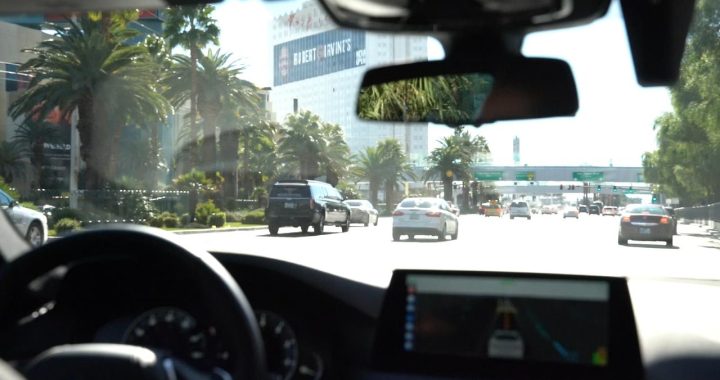A driverless share ride in Las Vegas is not to be missed. That was my thought when I heard that Uber’s main US rival Lyft was offering an autonomous car experience along some of the city’s busiest roads as part of this week’s Consumer Electronics Show.
On a sunny Vegas morning The Weekend Australian’s video journalist Taylor Denny and I ventured to a car park outside the city’s convention centre to try our luck and hail one. The Lyft smartphone app had geo-restricted driverless car access to people near this car park and we were warned about waits of up to 90 minutes due to the trial’s popularity.
I have been in autonomous vehicles before, in Adelaide and Melbourne, but that was mainly on cordoned-off sections of highway with no oncoming traffic, pedestrians and other obstacles, and no reason to stop en route. One of these journeys was a driverless trip with South Australian Premier Jay Weatherill.
This would prove a different experience. The shiny driverless BMW was licensed in Nevada to take us along the densely populated Las Vegas Boulevard to The Mandalay Bay Resort, the scene of last October’s horrific shooting where at least 59 people were murdered.
The car arrived with two people in it: a safety pilot and a guide. They came courtesy of Aptiv, the future mobility company that developed the technology.
The guide explained that the terms of the Nevada licence required a human to control the car on private property, when passengers got in and out, and when the car entered or left drop-off points. We were assured the car would travel autonomously for the rest of the 30 minute, 7km journey.
Indeed it did, and the trip was smooth. A person before me had described the ride as like being driven around by your grandmother. The car would take off and accelerate gently, although it would brake firmly at traffic signals. And it would tell us what it was doing, for example, when it was changing lanes.
Riding down the Las Vegas Strip in an autonomous car
When seeking to turn left or right, it would attempt to change lanes to the relevant side of the road, as a human driver would. In heavy traffic, it would wait for room on the far side of an intersection before venturing across, as we are supposed to.
The car was very conscientious at traffic signals. Whereas human drivers would race across an intersection on amber, this car would stop obediently.
Only once did the safety pilot intervene. A car parked on the roadside was obstructing traffic in our lane. Other cars were carefully moving around it, but the BMW stopped altogether. The pilot explained the car would have remained there forever unless she had taken control.
It’s still early days and Aptiv admits some systems are not in place. For example, this car would not realise it needed to refuel. If you let it drive around Vegas on its own, it would eventually stop in the middle of the street.
The car’s performance in traffic was impressive and Aptiv plans a 2019 rollout.
That means driverless taxis and share-ride vehicles will be feasible in a couple of years. Human driving jobs could start to disappear at that point.
But that’s just 30 per cent of the story. The real challenge with driverless car technology is to upgrade infrastructure around city streets to support it. There’s the issue of how insurance will operate when a human isn’t at the wheel. And there’s public safety. Are we humans ready to trust driverless cars running up and down the road outside the primary schools of our children?
Upgrading road infrastructure will be a massive job. In Australia, we don’t even have displays on most of our pedestrian ‘‘don’t walk” signs that show the time left to cross a road.
Traffic signals have to be wireless-capable in the driverless car age. Tod Moury, who develops Aptiv’s autonomous features, says its system uses two methods.
Working with the City of Las Vegas, Aptiv outfitted traffic signals with wireless communications along the 20 plus routes it is using for these demonstrations. The wireless communications is backed up by cameras in the car. Moury is “very confident” of the traffic light detection system’s safety and reliability.
“We know what’s going on not only with the traffic light we’re approaching, but the traffic lights in the area. We know a lot more about the traffic light conditions than a manual driver would.”
A combination of short range and long range LIDAR (radio) and radar units, and cameras at the front offers a 360-degree “envelope” for sensing objects around the vehicle.
Moury says Aptiv had developed high definition maps to help cars decide when to change lanes. Signage such as a new speed limit can be included in the maps, or a camera can interpret that sign.
Aptiv expects to have its commercial fleet driverless application ready for sale in 2019. Companies could then run their own autonomous car operation, in theory at least.
He says Lyft vehicles would continue to operate with a safety pilot for the foreseeable future. Aptiv was working with partners around the world who wanted this technology.
Chris Griffith travelled to CES in Las Vegas courtesy of Samsung Australia. Published in The Australian newspaper.
